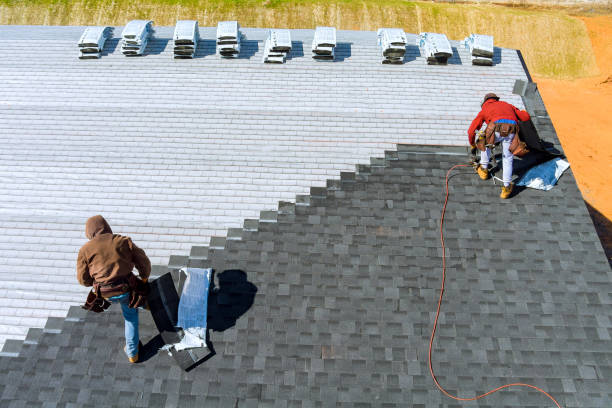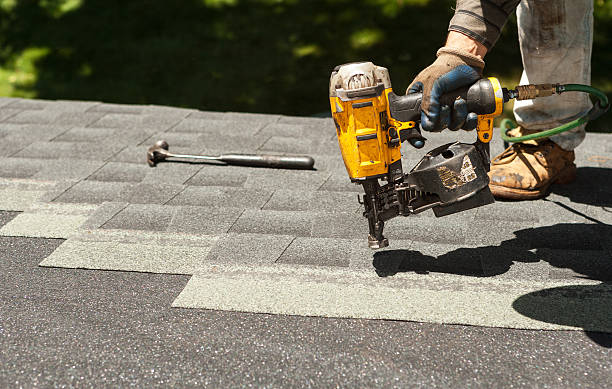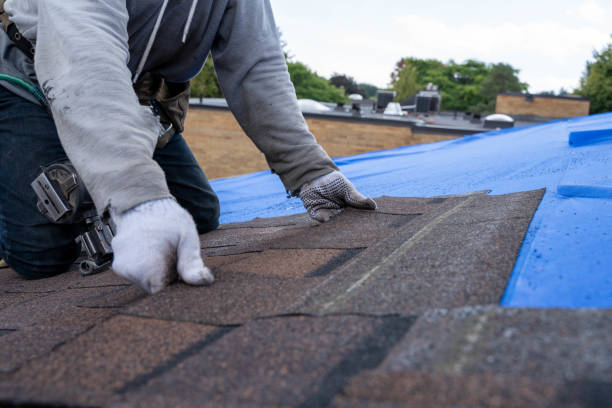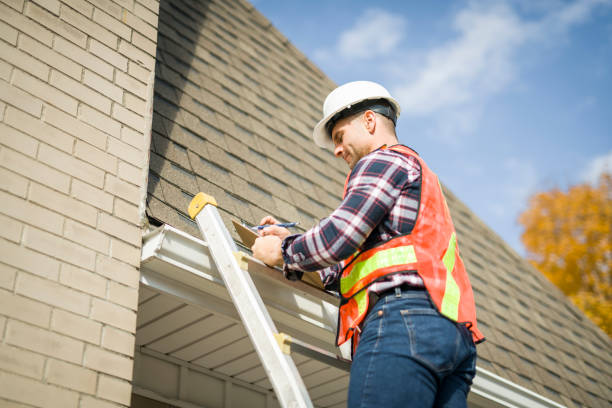Understanding Roofing Repair Service Saint Michael Minnesota: Everything You Need to Know

Roof replacement is a critical home improvement project that ensures your property remains safe, energy-efficient, and structurally sound. If you’re unfamiliar with the process, understanding the basics can help you make informed decisions about your roof and its maintenance. Below, we break down the essential aspects of roof replacement.
What Is Roof Replacement?
Roof replacement involves removing your existing roof system down to its decking (in most cases) and installing a new one. This process restores the integrity of your roofing system while addressing potential structural issues. It differs from repairs, which only target specific sections of damage.
- Removing old shingles or roofing materials
- Inspecting the underlying decking for damage
- Repairing or replacing any compromised sections
- Installing underlayment for added protection
- Placing new roofing materials such as shingles, tiles, or metal panels
- Finishing touches like ridge caps, flashing, and ventilation components
When Is Roof Replacement Necessary?
- Widespread leaks or water infiltration
- Warped or sagging decks due to structural issues or rot
- Asphalt shingles typically last 20–30 years
- Metal roofs may last 40–70 years
- Recurring leaks despite repeated repairs
- High energy bills due to poor insulation caused by roofing problems
Benefits of Roof Replacement
- Improved Safety: A new roof eliminates risks like collapse or further water damage.
- Energy Efficiency: Modern roofing systems better regulate indoor temperatures and reduce energy costs.
- Increased Property Value: A durable and aesthetically pleasing roof enhances curb appeal and boosts resale value.
- Long-Term Savings: While an upfront investment, a new roof minimizes future repair expenses.
The Role of Professional Roofers in Replacements
| Aspect | Professional Roofers | DIY Approach |
| Expertise | In-depth knowledge of materials and methods | Limited experience |
| Time Efficiency | Faster completion with specialized tools | Longer duration due to learning curves |
| Warranty/Guarantee | Workmanship warranties provided | No guarantees on DIY results |
| Safety | Adherence to safety standards | Risk of accidents without proper training |
Questions to Ask Before Starting a Roof Replacement Project
- What type of material is best suited for my climate?
- Are there any local building codes I should be aware of?
- Does my homeowner’s insurance cover part of the costs?
- How long will the project take from start to finish?
By understanding these basics, you’ll be prepared to handle this essential home improvement task with confidence and clarity.
Top Reasons to Call Roofing Contractors Saint Michael Minnesota for a New Roof Replacement
Identifying when your roof needs replacement is essential for maintaining the safety and structural integrity of your home. Overlooking the warning signs could lead to costly repairs, water damage, or even health hazards such as mold. Here are some of the most critical indicators that it’s time to consider a new roof replacement.
Finding an Expert Roofing Repair Company in Saint Michael Minnesota for Aging Roofs
The lifespan of a roof largely depends on its material:
| Roofing Material | Expected Lifespan | |—————————|—————————| | Asphalt Shingles | 20-30 years | | Metal Roofing | 40-70 years | | Wood Shakes and Shingles | 25-30 years | | Clay or Concrete Tiles | 50+ years |
If your roof has outlived its typical lifespan, replacement should be on your radar regardless of visible damage.
Signs You Need a Roofing Company Saint Michael Minnesota: Curling, Cracked, or Missing Shingles
Shingles are your roof’s first line of defense against weather elements. If you notice:
– Curling edges: Indicates shingles have aged or been exposed to moisture over time.
– Cracks: Often caused by prolonged sun exposure or heavy impacts from hailstorms. – Missing shingles: Exposes the underlayment and increases vulnerability to leaks.
These issues compromise the integrity of your roof and leave it susceptible to additional damage.
Signs You Need a Roofing Service Saint Michael Minnesota: Water Damage and Leaks
Signs of water intrusion include:
– Stains on walls or ceilings.
– Sagging areas in the attic or ceiling due to pooled water. – Dripping water during rainstorms.
Water leaks not only weaken structural components but can also lead to mold growth, posing health risks for occupants.
Granule Loss in Gutters: Common Signs You Need Roofing Repair Saint Michael Minnesota
If you find excessive granules in gutters after heavy rain, it’s an indication that shingles are deteriorating. Loss of granules reduces UV protection and accelerates wear on shingles.
Signs of Sagging Roofing in Saint Michael Minnesota
A drooping roof is a severe issue that often points to structural problems such as compromised decking or framing caused by moisture buildup over time. This situation requires immediate professional attention.
How Roof Installation Saint Michael Minnesota Can Help Lower Increasing Energy Bills
A poorly insulated roof with damaged materials can affect temperature regulation inside your home, causing heating and cooling systems to work harder than usual — reflected in higher energy bills.
When Should You Call Roofers Saint Michael Minnesota?
If you notice several signs listed above, consult with a professional roofing contractor promptly for an inspection. Delaying action could result in further damage to other parts of your home and increased repair costs down the road.
By proactively identifying these key signs, you can prioritize safety while ensuring the longevity and efficiency of your property’s roofing system.
Understanding Roof Replacement Costs and Budgeting Tips
When planning for a roof replacement, understanding the associated costs and how to budget effectively is essential. Roof replacement is a significant investment, and being informed can help you make the best decisions for your home or building. Below, we’ll break down key cost factors, budgeting tips, and strategies to ensure you’re financially prepared.
Key Factors Influencing Roof Replacement Costs
- The larger the roof, the more materials and labor will be required.
- Costs are typically calculated per square foot or roofing square (100 square feet).
- Different materials come with varying price points. For example: | Roofing Material | Average Cost per Square Foot | |————————–|——————————-| | Asphalt Shingles | $3–$5 | | Metal Roofing | $6–$12 | | Clay Tiles | $8–$15 | | Slate | $10–$20 |
- A simple roof with fewer angles or features will cost less to replace compared to intricate designs with dormers, chimneys, or skylights.
- Labor charges vary depending on location, contractor availability, and expertise.
- Local regulations may require permits for roofing projects.
- Fees for disposing of old materials are often factored into overall costs.
Tips for Creating an Accurate Budget
- Get Multiple Quotes
Always obtain at least three estimates from licensed roofing contractors to compare costs accurately. - Factor in Unexpected Expenses
Set aside 10-15% of your budget for unforeseen issues like structural repairs or water damage discovered during the process. - Choose Materials Based on Longevity vs Cost
While premium materials like slate may seem expensive upfront, their durability can save money over time by reducing future maintenance or replacement needs. - Consider Financing Options
If replacing a roof requires upfront capital you don’t have readily available:- Look into low-interest home improvement loans.
- Explore contractor financing programs if offered.
- Schedule Routine Maintenance After Replacement
Regular inspections extend your new roof’s lifespan and help avoid costly repairs down the road.
Cost-Saving Strategies Without Compromising Quality
- Opt for mid-range materials that balance affordability with durability.
- Replace your roof during off-season months when demand is lower (commonly late winter).
- Research contractor reviews thoroughly; a lower quote isn’t always worth sacrificing expertise.
- Ask about warranty options that can further protect your investment over time.
Understanding these factors will help ensure you’re financially prepared when replacing your roof while maintaining control over costs without compromising quality.
Finding the Best Roofing Repair Contractors Saint Michael Minnesota for Your Home
When planning for a roof replacement, understanding the costs associated with different roofing materials is essential. Each material comes with unique price points, durability levels, and maintenance demands. Below is a detailed guide outlining the costs by material type and the factors that influence these prices.

Factors Influencing Roofing Costs
- Size of the Roof: Larger roofs require more materials and labor.
- Roof Complexity: Features such as valleys, skylights, or steep slopes can increase labor costs.
- Local Labor Rates: Roofing costs vary depending on regional labor charges.
- Material Quality: High-quality materials are more expensive but often last longer.
- Removal of Old Roof: Additional expenses may arise if the old roof needs to be torn off and disposed of.
Cost Breakdown by Roofing Material
| Roofing Material | Average Cost (Per Sq. Ft.) | Lifespan | Maintenance Requirement |
| Asphalt Shingles | $3 – $6 | 20-30 years | Low |
| Metal Roofing | $5 – $14 | 40-70 years | Low to Moderate |
| Wood Shingles/Shakes | $6 – $12 | 25-35 years | Moderate |
| Clay Tiles | $10 – $18 | 50+ years | Low |
| Concrete Tiles | $9 – $12 | 50+ years | Low |
| Slate | $15 – $30 | 75+ years | Very Low |
Asphalt Shingles
Asphalt shingles are among the most commonly used roofing materials due to their affordability and ease of installation. While they provide reliable weather resistance, they may need replacement sooner compared to premium options like slate or metal.
Metal Roofing
Metal roofs offer modern aesthetics combined with exceptional durability. They can withstand harsh weather conditions but may have higher upfront costs. However, their longevity often offsets this expense over time.
Wood Shingles/Shakes
For homeowners seeking a natural look, wood shingles or shakes can be an attractive choice. These roofs require regular maintenance, such as treating for moisture or insect damage, which adds to their lifetime cost.
Clay and Concrete Tiles
Clay and concrete tiles are popular in hotter climates thanks to their ability to reflect heat. While both options are heavy (requiring a strong roof structure), they add significant curb appeal and last decades with minimal upkeep.
Slate
Slate is one of the most durable roofing materials available but comes at a premium price point. Its natural stone appearance adds elegance to any home while providing unparalleled longevity.
Tips for Choosing the Right Material for Your Budget
- Assess Long-Term Value: While some materials have higher upfront costs, their extended lifespan may save you money in the long run.
- Consider Energy Efficiency: Materials like metal or clay tiles can improve insulation and reduce energy bills.
- Evaluate Maintenance Costs: Some options may require continuous upkeep—factor these expenses into your decision-making process.
- Understand Local Climate Needs: Choose a material that can handle your region’s weather patterns effectively.
By carefully considering these factors alongside your budgetary constraints, you can select the roofing material that best suits your needs while ensuring maximum value for your investment.
Step-by-Step Process of How a Roof Is Replaced Professionally
Roof replacement is a significant investment, and understanding the process can help homeowners feel more confident and prepared. Below is a detailed step-by-step guide to how professional roofers replace a roof efficiently and effectively.
1. Initial Inspection and Assessment
- Comprehensive Inspection: Professional roofers begin by examining the current condition of your roof. This includes identifying damage like leaks, missing shingles, or structural issues.
- Detailed Estimate: After the inspection, you’ll receive a detailed estimate outlining labor costs, materials needed, and any additional repairs.
2. Preparing the Worksite
- Protecting Your Property: To ensure minimal disruption and damage to your property, contractors cover landscaping, windows, and HVAC units with protective tarps or plywood.
- Safety Measures: Roofing teams adhere to safety standards by setting up ladders securely and ensuring all workers use proper harnesses.
3. Removal of the Old Roof
This step involves stripping away the existing roofing materials: – Tearing Off Old Shingles or Materials: The old shingles or other roofing materials are carefully removed down to the decking. – Inspecting Decking: The bare decking is inspected for rot or weak spots that need repair before new materials are installed.
4. Repairs to Roof Decking (If Necessary)
Should any issues be identified during inspection: – Contractors replace damaged wood or other structural components to ensure a strong foundation for your new roof.
| Issue Found | Typical Solution | Estimated Cost* |
| Rotting Wood | Replace plywood sheets | $40–$70 per sheet |
| Weak Spots | Reinforce with structural fixes | Varies by extent |
(*Actual costs may vary depending on location.)
5. Installation of Underlayment
The underlayment is a vital barrier that protects against moisture penetration: – Waterproof Layer: A synthetic or felt underlayment is laid over the decking. – Attention to Detail: Professionals ensure there are no gaps or wrinkles in this layer.
6. Flashing Installation
Flashing protects vulnerable areas like chimneys, skylights, and valleys: – Flashing prevents water from seeping into joints and corners.
Properly installed flashing is crucial for long-term waterproofing.
7. Installing New Roofing Material
Whether you’ve chosen asphalt shingles, metal panels, clay tiles, or another material type: – Professionals begin at the bottom edge of the roof and work upward in overlapping layers.
| Material Type | Typical Installation Method | Lifespan |
| Asphalt Shingles | Nailed in overlapping rows | 20–30 years |
| Metal Panels | Screwed down with fasteners | 40–70 years |
| Clay/Concrete Tiles | Individually placed over underlayment | 50+ years |
8. Cleanup Process
Once installation is complete: – Contractors remove debris from your yard. – Magnetic tools are often used to collect stray nails left behind during construction.
A final walkthrough ensures everything meets quality standards before concluding work on-site.
Professional roof replacement follows these steps meticulously to ensure durability and performance over decades. Working with experienced roofers ensures that every detail – from preparation to cleanup – is managed efficiently while maintaining high-quality results.

Step-by-Step Process of How a Roof Is Replaced Professionally
Replacing a roof is a complex process that requires careful planning, expertise, and precision. Hiring professional roofers ensures the job is completed efficiently and safely. Below is a detailed step-by-step breakdown of how a roof replacement is conducted by experts.
Initial Assessment and Inspection
- Roofers perform a detailed inspection to assess the condition of the existing roof.
- They identify issues like leaks, damaged shingles, rotting wood, or inadequate ventilation.
- Based on the inspection, professionals provide an estimate that includes labor costs, materials, timeline, and any additional repairs required.
Preparation for Roof Replacement
- Before starting work, contractors secure any permits required by local authorities to ensure compliance with building codes.
- Professional roofers cover landscaping with tarps or plywood to protect it from falling debris during the replacement process.
- Gutters are safeguarded to avoid accidental damage during installation.
- The roofing materials (e.g., shingles, flashing) are delivered on-site before work begins to ensure no delays occur.
Removal of the Old Roof
- The old roofing material is carefully removed down to the decking layer beneath.
- All nails and fasteners are extracted to create a clean surface for installation.
- Professionals check for rot or structural issues in the decking once the old roof has been stripped.
- Damaged sections are replaced to ensure proper support for the new roof.
Installation of New Roofing System
- A waterproof underlayment or felt paper is applied to provide an extra layer of protection against water infiltration.
- Flashing around chimneys, valleys, vents, and skylights is installed or replaced as needed to prevent leaks in vulnerable areas.
- Shingles or other chosen materials are installed using precise alignment techniques.
- Contractors follow manufacturer guidelines for securing each layer properly.
- Proper attic ventilation systems (such as ridge vents) may be installed or updated if necessary for airflow efficiency and longevity of roofing materials.
Final Inspections and Cleanup
- A thorough inspection ensures that all work meets industry standards and there are no imperfections in installation.
- Professionals confirm that all flashing has been sealed properly and there are no gaps or loose materials.
- Debris generated from tearing off old roofing material is removed from the property.
- Nails are collected using magnets to ensure safety in surrounding areas.
- Homeowners receive documentation covering warranties for both materials used and labor provided by the contractor.
Benefits of Professional Roof Replacement
- Safety: Expert teams use proper tools and techniques to minimize risks associated with working at heights.
- Efficiency: Professionals complete projects faster due to experience and access to specialized equipment.
- Warranty Coverage: Most professional services offer warranties for their workmanship alongside manufacturer warranties on materials.
- Compliance with Codes: Contractors ensure all work aligns with building regulations in your area.
By understanding each step involved in professional roof replacement, homeowners can better appreciate both its complexity and importance in maintaining their property’s structural integrity over time.
Different Types of Roofing Materials and Their Benefits
When considering a roof replacement or installation, selecting the right roofing material is one of the most critical decisions. Each type of roofing material offers unique benefits in terms of durability, aesthetic appeal, cost, and energy efficiency. Below is a detailed overview of popular roofing materials and their advantages to help you make an informed decision.
Asphalt Shingles
Asphalt shingles are the most commonly used roofing material in residential projects. They are affordable, easy to install, and available in various colors and styles. – Benefits: – Cost-effective option compared to other materials. – Low maintenance requirements. – Come in a wide range of colors and textures. – Lifespan: Typically lasts 15-30 years depending on quality.
Metal Roofing
Metal roofs are gaining popularity due to their durability and modern aesthetic. They are available in materials like aluminum, steel, copper, or zinc. – Benefits: – Highly durable with a lifespan of 40-70 years. – Resistant to extreme weather conditions such as heavy rain or snow. – Reflects heat, improving energy efficiency. – Lightweight yet strong.
Clay Tiles
Clay tiles bring a timeless appearance often associated with Mediterranean-style homes. These tiles offer exceptional longevity but can be on the pricier side. – Benefits: – Extremely durable with a lifespan exceeding 50 years if properly maintained. – Resistant to fire and rot. – Outstanding insulation properties for warmer climates.
| Feature | Clay Tiles |
| Lifespan | Over 50 years |
| Climate Suitability | Warm climates |
| Cost | Higher upfront cost |
Slate Roofing
Slate is one of the most premium options for roofing materials. It is known for its natural beauty and incredible durability. – Benefits: – Exceptional longevity; can last over a century with proper care. – Highly resistant to damage from fire or moisture infiltration. – Eco-friendly as it’s made from natural stone.
Wood Shakes or Shingles
Wood shingles offer an organic aesthetic that blends well with natural surroundings. Commonly made from cedar, these roofs add charm but require regular maintenance.
- Provides excellent insulation properties.
- Sustainable options available! -Brief comparative conclusion
Different Types of Roofing Materials and Their Benefits
Choosing the right roofing material for your home or building is a critical decision that impacts both the functionality and aesthetics of your property. Each material comes with its own set of advantages, making it crucial to assess your specific needs, budget, and the local climate before making a choice. Below is an overview of some popular types of roofing materials and their benefits.
Asphalt Shingles
Asphalt shingles are one of the most widely used roofing materials in residential construction. They are favored for their affordability and ease of installation.
Benefits: – Cost-effective: Asphalt shingles are budget-friendly compared to other materials. – Variety: Available in numerous colors, styles, and textures to match architectural preferences. – Durability: Can last 20–30 years with proper maintenance. – Ease of Repair: Individual shingles can be replaced without major disruption.
| Feature | Asphalt Shingles |
| Lifespan | 20–30 years |
| Cost | Low |
| Installation Effort | Easy |
Metal Roofing
Metal roofs have been gaining popularity due to their longevity, sleek appearance, and energy efficiency.
Benefits: – Durability: Can last 40–70 years or more with minimal maintenance. – Energy Efficiency: Reflects sunlight, reducing cooling costs during warm months. – Lightweight: Puts less stress on the structure compared to heavier materials like tile or slate. – Recyclable: Often made from recycled content and can be recycled at the end of its life cycle.
Common Types of Metal Roofing: – Aluminum – Steel – Copper – Zinc
Clay and Concrete Tiles
Clay and concrete tiles are known for their durability and distinctive Mediterranean aesthetic.
Benefits: – Longevity: Can last over 50 years under proper conditions. – Fire Resistance: Non-combustible material ensures better protection against fire hazards. – Aesthetic Appeal: Adds an elegant look that complements various architectural styles.
However, they are much heavier than other options, so structural reinforcement might be necessary.
Slate Tiles
Slate offers unparalleled elegance combined with incredible durability. It’s often regarded as a premium roofing material.
Benefits: – Exceptional Longevity: Lasts over 75 years; some installations exceed 100 years. – Natural Beauty: Available in natural shades like gray, green, purple, and black that enhance curb appeal. – Eco-Friendly: A natural material that requires minimal processing.
Keep in mind that slate is among the most expensive choices available on the market due to its high quality.
Wood Shingles/Shakes
Wooden roofing provides a rustic charm that’s particularly suitable for cottages or historic homes.
Benefits: – Aesthetic Appeal: Offers a warm, natural look unmatched by synthetic alternatives. – Insulation Properties: Provides better insulation compared to some other materials.
While visually appealing, wood requires consistent maintenance to prevent mold or rot caused by moisture exposure.
Synthetic Roofing Materials
Synthetic options such as rubber or polymer-based composite shingles mimic higher-end materials like slate or wood but at a fraction of the cost.
Benefits: – Affordability: Provides the look of expensive materials without breaking your budget. – Lightweight & Easy Installation: Reduces labor costs and installation timeframes.
| Material Type | Longevity | Key Benefit |
| Asphalt Shingles | 20–30 years | Affordable & versatile |
| Metal Roofing | 40–70+ years | Durable & energy efficient |
| Clay/Concrete Tiles | 50+ years | Fire-resistant & stylish |
| Slate | 75–100+ years | Long-lasting & luxurious |
| Wood Shingles/Shakes | ~30 years | Natural rustic charm |
| Synthetic Materials | ~50+ years | Cost-effective durability |
Factors to Consider When Choosing Roofing Materials
- Assess your budget while keeping long-term costs in mind (e.g., maintenance).
- Understand your local climate conditions—some materials perform better in cold climates while others excel in heat resistance.
- Consider aesthetic preferences based on what complements your property’s exterior design style.
- Evaluate environmental impact if sustainability matters to you (e.g., metal roofs being recyclable).
By understanding these factors alongside the advantages offered by each type of roofing material, homeowners can make informed decisions tailored to their unique needs.
- Step-by-Step Guide to Hiring Roofing Repair Contractors Saint Michael Minnesota and What to Expect
- Understanding Roofing Repair Service Saint Michael Minnesota: Everything You Need to Know
- Expert Tips from a Roofing Repair Company Saint Michael Minnesota on Drip Edge Installation
- Assessing the Condition of Your Current Roof
- 7 Essential Steps to Choose Roofing Repair Contractors Saint Michael Minnesota
- Finding the Best Time for Roofing Repair Service Saint Michael Minnesota
- What to Expect During Your Roof Installation with Roofing Contractors Saint Michael Minnesota




